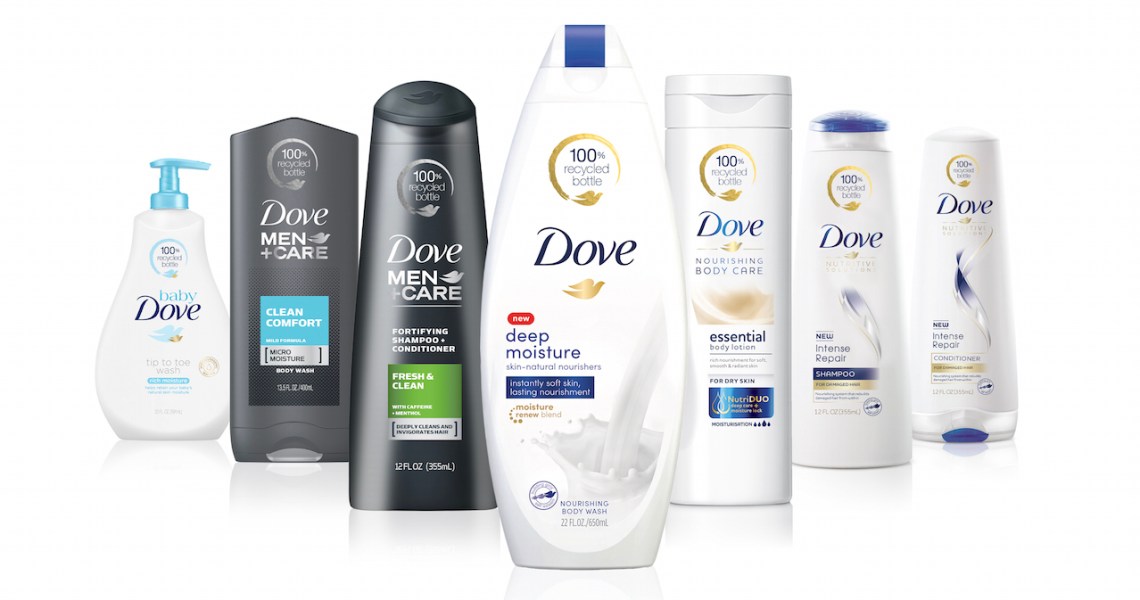On Monday, Unilever announced its boldest sustainability initiative yet: It plans to incorporate 100% post-consumer recycled plastic into its biggest brands, Dove, Dove Men+Care and Baby Dove by 2025.
The overall Dove brand is distributed in 171 countries and bottles require almost two-thirds of all plastic that the brand uses, according to Amy Stepanian, Dove and Dove Men+Care U.S. brand director. Dove’s efforts will start with the North American and European markets. Products across all three lines using recycled plastic have already begun appearing on store shelves.
Unilever announced in 2017 that its plastic packaging would be reusable, recyclable or compostable by 2025, but it did not detail how or what brands it would begin with. Due to the lack of federal regulations and industry standards around sustainability, Dove is positioned to set a precedent that will trickle down to retailers and smaller brands.
“[This] sees our first major milestone toward dramatically reducing and eliminating the amount of virgin plastic used in our products,” said Stepanian. “The benefits of the circular economy are clear for business and the environment. More effective use of materials means lower costs, less waste, [and] better risk management of raw materials and supply chain.”
A notable caveat to Dove’s 100% recycled plastic plan is that there are components of the bottles, such as caps and pumps, that cannot be made yet from recycled plastics, underscoring the ongoing difficulty of adopting sustainable practices. According to market research firm Euromonitor International, the beauty industry’s demand for plastics exceeded 153 billion units in 2018, and 40% of those products were packaged with single-use plastic and ended up in a landfill. Unilever expects that its Dove efforts will eliminate the use of 20,500 tons of virgin plastic use per year.
“By using one of the largest Unilever brands, it drives scale and impact,” said Brett Domoy, Unilever director of packaging engineering. Unilever did not disclose the investment in its sustainability plans.
In Unilever’s most recent earnings in October 2019, it reported that the beauty and personal-care category experienced 2.8% year-over-year growth in sales, reaching $6.1 billion. Unilever does not break out sales for individual brands.
Ad position: web_incontent_pos1
Domoy said the new packaging required over 100 trials across the Dove product portfolio to ensure that the performance was on par with existing bottles. This meant testing for leaks and compatibility with existing formulas and making sure bottles did not break when dropped.
Within the beauty and consumer products industry, there is a broader debate over what methods will benefit the environment the most. Some brands like L’Oreal’s Seed Phytonutrients have opted for biodegradable packaging, while L’Occitane is considering reusable and refillable bottles. In addition to its plans for Dove, Unilever has 100 other sustainability initiatives across its global portfolio, according to Stepanian. This runs the gamut from an open-source technology launched in 2013 meant to help other companies create products using less plastic to testing reusable bottles for its REN Clean Skincare and Love Beauty & Planet brands. Still, Dove represents the company’s widest-reaching sustainability program.
Unilever competitors have also established their own sustainability goals. P&G announced in 2018 plans to offer 100% recyclable or reusable packaging by 2030. L’Oreal USA has focused on reducing carbon emissions through the purchase of renewable natural gas, among other goals.
Coinciding with Dove’s announcement, the brand will host a one-day consumer installation at the Grand Central train terminal in New York City on Friday, Jan. 31. The purpose is to introduce the recycled plastic initiative to a larger audience. Visitors will be invited to bring a plastic item for recycling in exchange for a Dove body wash packaged in a 100% recycled plastic bottle.
“To move toward a circular economy, we need the whole consumer goods industry on the journey, which means moving from individual company efforts to joint industry action,” said Stepanian.




